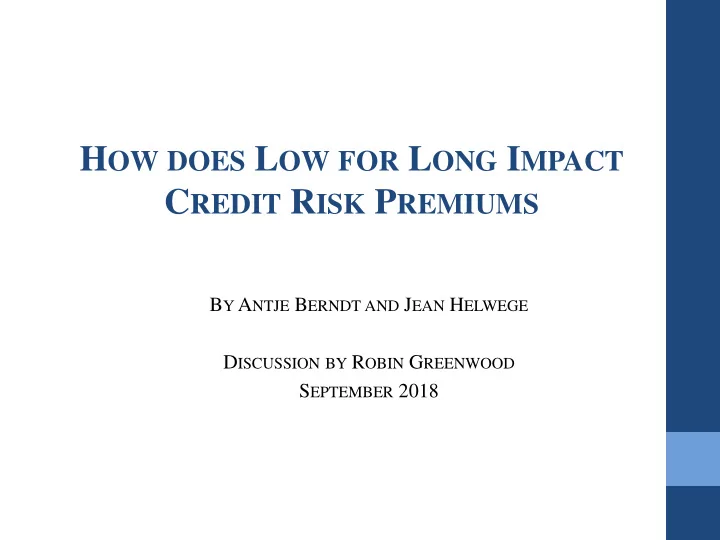

H OW DOES L OW FOR L ONG I MPACT C REDIT R ISK P REMIUMS B Y A NTJE B ERNDT AND J EAN H ELWEGE D ISCUSSION BY R OBIN G REENWOOD S EPTEMBER 2018
C ENTRAL Q UESTION • Many people believe that the Fed’s extended period of QE and low short rate have induced risk taking by financial market participants • Can we detect this in the pricing of corporate credit? • This paper • Persuasively shows that credit risk premia are not at disturbing levels compared to historical experience • Compares CDS spreads to measures of expected default to estimate premia • Shows that credit risk premia did not move much with QE announcements • My comments today • Overall, I found the evidence on pricing to be persuasive, and it moved my priors on this topic • However, evidence on prices needs to be evaluated in conjunction with quantities • It still seems likely that we are sitting on a tinderbox • There is lots of great material in the paper, I will only touch on a few points
C REDIT S PREADS
M AIN A PPROACH • Credit Risk Premium = Credit Spread – Expected Default*Recovery • Credit spread obtained from CDS Prices • Clearly, results depend on Expected default model • In general, with any structural model, more faith in estimates of changes than in levels • Then analyze: • Event studies of QE dates • Time series
F OR COMPARISON • Gilchrist and Zakrajsek (various years) have a competing measure, based on bond prices
I SSUES WITH THE APPROACH (1) • Using the CDS spread implicitly takes a view on • Integration of the cash and CDS markets • Where the credit risk premium comes from • Expectations/Sentiment/Reaching for yield • Risk aversion • Whether taking CDS spread or bond spread as the measure of risk- neutral probability depends on what were the non-fundamental forces. For example, during the crisis • On the bond side, there were forced deleveraging by bond holders and breakdown of repo market which made financing bond purchases by arbitrageurs harder. • On the CDS side, there were perceived counterpart risk in CDS contracts, since CDS contracts were written by banks. The demand for CDS protection is probably less because of possible defaults by banks. • Hard to tell whether the bond spread or CDS spread is a better measure of market implied risk-neutral expectation • I am persuaded by the evidence, but can the authors make a case?
CDS BOND BASIS Tight basis today Bond spread much wider than CDS
I SSUES WITH THE APPROACH (2) • How directly do we think is the link between changes in short rates and reaching for yields (levels, changes) • Some evidence that reaching for yield is immediate • Hanson, Lucca, Wright (2018), SR>LR • Intuition suggests might play out over a longer horizon • My favored account of the credit cycle • Fed lowers rates • This induces reach-for-yield behavior • In the short-run, this lowers risk of high yield credits, making them appear safe ex post • An expectations cycle kicks in, further reducing credit “risk premia” • Much like output-inflation cycle, there are variable leads and lags here, making measurement difficult • This gives me some license as a discussant
E VENT S TUDY E VIDENCE (3) Paper finds Very little Movement around QE Announcement Dates
G AGNON ET AL
B UT HORIZON MATTERS Source: Mamaysky 2018
I SSUES WITH E VENT STUDY ANALYSIS • Assumes perfect integration of credit/CDS/ Treasury markets at all horizons • Greenwood, Hanson, Liao (2018) suggest unrealistic • Correcting for impact that QE has on actual default probability is fraught with difficulty, making changes in both credit spreads and CDS prices hard to evaluate
I SSUES WITH THE APPROACH (4) • The paper is solely concerned with prices, but a financial stability assessment would also consider: • Non-price features of the debt • Becker and Ivashina (2018), cov-lite etc • Quantities • Greenwood and Hanson (2013), Baron and Xiong (2017)
C OV -L ITE SHARE 80 % Cov-Lite loans (e.w) % Ex. Quasi Cov-Lite 70 60 50 % 40 30 20 10 0 1996q4 1998q4 2000q4 2002q4 2004q4 2006q4 2008q4 2010q4 2012q4 2014q4 2016q4 Becker and Ivashina 2018
C REDIT G ROWTH
L OAN O FFICER S URVEY
I SSUANCE
T HE BBB S HARE TINDERBOX
W HERE DOES THIS LEAVE US • The pricing evidence that Berndt and Helwege present suggests that pricing is much like any other credit boom, and not as extreme as the last one • But all of this needs to be caveated with • High credit growth overall • Other estimates of credit risk premia suggest the market is bullish • Need to have greater clarity as to whether CDS is the right place to study risk premia • Combination of high growth and pretty low spreads suggests that a credit correction will produce a garden variety credit crunch, but most likely nothing like 2008 • In my opinion, this is a fruitful area of research, and more explorations such as Berndt and Helwege present should be done
Recommend
More recommend